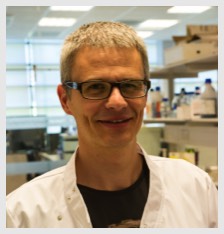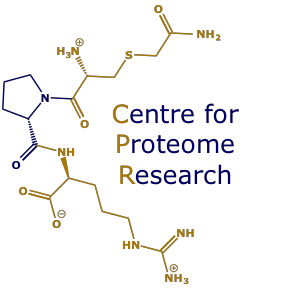
Dr Dean Hammond
Postdoctoral reseacher
LabA, Centre for Proteome Research
Institute of Integrative Biology
University of Liverpool,
Crown Street
Liverpool L69 7ZB
Tel: +44 151 794 5344
Tel: +44 151 795 4392
Email: becks11[at]liv.ac.uk
Postdoctoral reseacher
LabA, Centre for Proteome Research
Institute of Integrative Biology
University of Liverpool,
Crown Street
Liverpool L69 7ZB
Tel: +44 151 794 5344
Tel: +44 151 795 4392
Email: becks11[at]liv.ac.uk
My career began with a BSc in Physiology from the University of Sheffield in 1992. After this, I worked in the construction industry for a number of years during which I studied part-time for a MSc in Human Neurobiology from Sheffield Hallam University (1998). Following this I was awarded a Wellcome Trust Prize PhD studentship in the Institute of Translational Medicine (ITM) at the University of Liverpool where, under the supervision of Prof. M. Clague, I characterised in detail how endocytic trafficking of the receptor Tyrosine Kinase MET influences its signalling output. MET is the receptor for hepatocyte growth factor (HGF), a major environmental inducer of the invasive growth phenotype required for morphogenetic events in both embryonic and adult life, as well as the malignant progression of several types of tumours.
For my first and second postdoctoral positions, I remained within the ITM, initially working on the RAS oncogene (with Prof. Ian Prior), comparing the relative efficiencies with which different growth factors activate the different isoforms of RAS, profiling the contribution made by each isoform to the total RAS pool in various tumour cell-lines and also investigating how RAS isoform-specific siRNA knockdown can influence signalling outcome(s). During this work, several new quantitative proteomics strategies for comparative analysis of global cell signalling pathways were published (specifically, using Stable Isotope Labelling with Amino Acids in Cell Culture [SILAC] combined with Mass Spectrometry [MS]). In my second post-doctoral position I established these approaches within the ITM and performed the first comprehensive analysis of HGF-dependent signalling via SILAC and MS and the first comparative phosphoproteomic study of HGF vs. Epidermal Growth Factor signalling outputs (with Prof. Clague). In parallel, I also worked with Prof. Rob Beynon in the Institute of Integrative Biology (IIB), and contributed to the development of “dynamic SILAC”, a method to determine the degradation rates of individual proteins on a proteome-wide scale using MS.
cont’d…
For my first and second postdoctoral positions, I remained within the ITM, initially working on the RAS oncogene (with Prof. Ian Prior), comparing the relative efficiencies with which different growth factors activate the different isoforms of RAS, profiling the contribution made by each isoform to the total RAS pool in various tumour cell-lines and also investigating how RAS isoform-specific siRNA knockdown can influence signalling outcome(s). During this work, several new quantitative proteomics strategies for comparative analysis of global cell signalling pathways were published (specifically, using Stable Isotope Labelling with Amino Acids in Cell Culture [SILAC] combined with Mass Spectrometry [MS]). In my second post-doctoral position I established these approaches within the ITM and performed the first comprehensive analysis of HGF-dependent signalling via SILAC and MS and the first comparative phosphoproteomic study of HGF vs. Epidermal Growth Factor signalling outputs (with Prof. Clague). In parallel, I also worked with Prof. Rob Beynon in the Institute of Integrative Biology (IIB), and contributed to the development of “dynamic SILAC”, a method to determine the degradation rates of individual proteins on a proteome-wide scale using MS.
cont’d…
B.Sc. University of Sheffield
M.Sc Sheffield Hallam University
Ph.D. University of Liverpool
M.Sc Sheffield Hallam University
Ph.D. University of Liverpool
cont’d …
In my third post-doctoral position I moved to the laboratory of Prof. Francis Barr, then in the Liverpool CRUK Cancer Research Centre, where I developed a novel label-free MS-based unbiased screening strategy to identify the substrates of mitotic serine/threonine phosphoprotein phosphatases and continued to use SILAC-based MS approaches combined with classical biochemistry to study proteins and protein complexes involved in cell cycle progression. Prior to joining the CPR, I was also involved in an EU FP7 project adopting proteomic approaches to investigate refractory disease: specifically, utilising isogenic cell-lines harbouring tumourigenic mutations in the K-RAS protein, to help solve a fundamental problem in translational medicine, that of predicting individual patient response and resistance to cancer therapy (with Profs. Clague and Prior).
My current post, with Prof. Beynon within the CPR, is part of a two centre project to provide absolute quantification data for the yeast proteome and decipher the turnover kinetics of these proteins (CoPY project). My research history has given me a expertise in cell and whole organism physiology, proteomics, mass spectrometry, as well as bioinformatics and data analytics. Indeed, throughout my post-doctoral career I have gradually metamorphosed from primarily a 'wet-lab' biologist to a bioinformatics data analyst and this is a role that increasingly represents what I currently do on a day-to-day basis and what I enjoy doing. I often collaborate with colleagues from other departments within the university and work on a variety of projects where proteomic and informatics solutions can be used to help answer biological questions.
In my third post-doctoral position I moved to the laboratory of Prof. Francis Barr, then in the Liverpool CRUK Cancer Research Centre, where I developed a novel label-free MS-based unbiased screening strategy to identify the substrates of mitotic serine/threonine phosphoprotein phosphatases and continued to use SILAC-based MS approaches combined with classical biochemistry to study proteins and protein complexes involved in cell cycle progression. Prior to joining the CPR, I was also involved in an EU FP7 project adopting proteomic approaches to investigate refractory disease: specifically, utilising isogenic cell-lines harbouring tumourigenic mutations in the K-RAS protein, to help solve a fundamental problem in translational medicine, that of predicting individual patient response and resistance to cancer therapy (with Profs. Clague and Prior).
My current post, with Prof. Beynon within the CPR, is part of a two centre project to provide absolute quantification data for the yeast proteome and decipher the turnover kinetics of these proteins (CoPY project). My research history has given me a expertise in cell and whole organism physiology, proteomics, mass spectrometry, as well as bioinformatics and data analytics. Indeed, throughout my post-doctoral career I have gradually metamorphosed from primarily a 'wet-lab' biologist to a bioinformatics data analyst and this is a role that increasingly represents what I currently do on a day-to-day basis and what I enjoy doing. I often collaborate with colleagues from other departments within the university and work on a variety of projects where proteomic and informatics solutions can be used to help answer biological questions.
- Beynon RJ, Hammond D, Harman V, Woolerton Y. The role of proteomics in studies of protein moonlighting. Biochem Soc Trans. 2014 42(6):1698-703. Mini-review.
• Claydon AJ*, Hammond DE* and Beynon RJ. Experimental and Analytical Approaches to the Quantification of Protein Turnover on a Proteome-wide Scale. 2014 In ìQuantitative Proteomicsî (Eyers, C.E., & Gaskell, S.J., eds) RSC Publishing. Review.
• Hammond D*, Zeng K*, Espert A, Bastos RN, Baron RD, Gruneberg U, Barr FA. Melanoma-associated mutations in protein phosphatase 6 cause chromosome instability and DNA damage owing to dysregulated Aurora-A. J Cell Sci. 2013 126(15):3429-40.
• Dunsch AK, Hammond D, Lloyd J, Schermelleh L, Gruneberg U, Barr FA. Dynein light chain 1 and a spindle-associated adaptor promote dynein asymmetry and spindle orientation. J Cell Biol. 2012 198(6):1039-54.
• Bastos RN, Penate X, Bates M, Hammond D, Barr FA. CYK4 inhibits Rac1-dependent PAK1 and ARHGEF7 effector pathways during cytokinesis. J Cell Biol. 2012 198(5):865-80.
• Omerovic J*, Hammond DE*, Prior IA, Clague MJ. Global snapshot of the influence of endocytosis upon EGF receptor signaling output. J Proteome Res. 2012 11(11):5157-66.
• Hammond DE, Hyde R, Kratchmarova I, Beynon RJ, Blagoev B and Clague MJ. Quantitative analysis of HGF and EGF-dependent phosphotyrosine signalling networks. J Proteome Res. 2010 9(5): 2734-42.
• Buus R, Faronato M, Hammond DE, UrbÈ S and Clague MJ. Deubiquitinase activities required for hepatocyte growth factor-induced scattering of epithelial cells. Curr Biol. 2009 19(17): 1463-6.
• Doherty, MK, Hammond DE, Clague MJ, Gaskell SJ and Beynon RJ. Turnover of the human proteome: determination of protein intracellular stability by dynamic SILAC. J Proteome Res. 2009 8(1): 104-12.
• Omerovic, J*, Hammond, DE*, Clague, MJ and Prior, IA. Ras isoform abundance and signalling in human cancer cell lines. Oncogene 2008 27: 2754-62.
• Clague MJ, Hammond DE. Membrane traffic: catching the lysosome express. Curr. Biol. 2006 16: R416-8. Mini-review.
• Hammond DE, Carter S, Clague MJ. Met receptor dynamics and signalling. Curr. Top. Microbiol. Immunol. 2004 286: 21-44. Review.
• Hammond DE*, Carter S*, McCullough J, UrbÈ S, Vande Woude G, Clague MJ. Endosomal dynamics of Met determine signalling output. Mol. Biol Cell 2003 14:1346-54.
• Hammond DE, UrbÈ S, Vande Woude GF, Clague MJ. Down-regulation of MET, the receptor for hepatocyte growth factor. Oncogene 2001 20: 2761-70.
